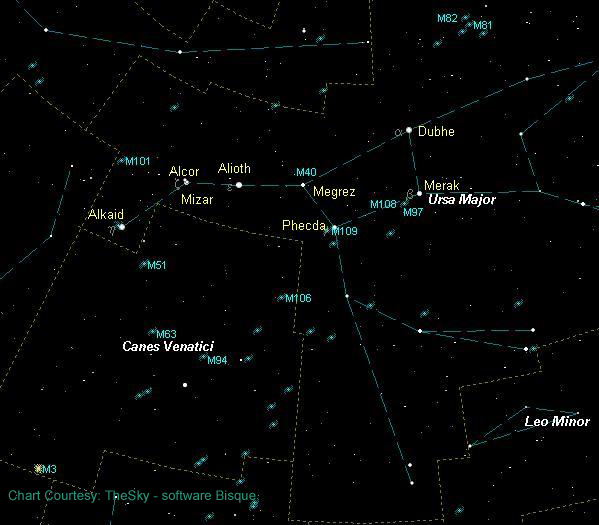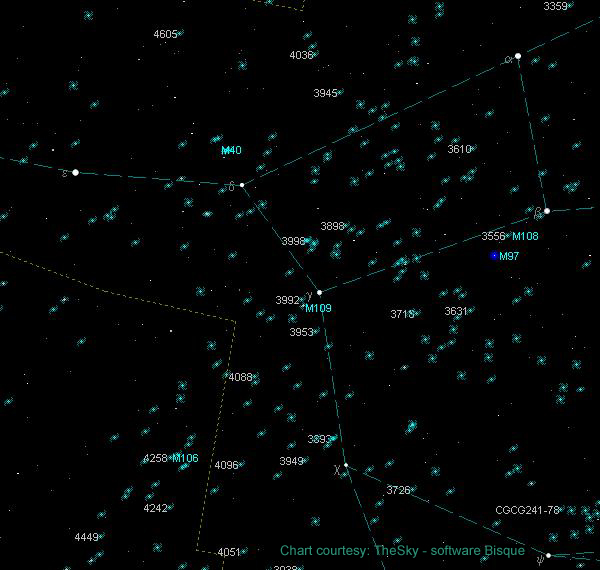The High Riding Bear
About an hour after sunset local – lookup, way up. What greets you is the most recognized constellation in the sky, Ursa Major – aka the Big Dipper or Big Bear. Taking up 1,280 square degrees of sky, it ranks third behind first-place Hydra and second place Libra. With the great beast prancing overhead, you will have a great opportunity to examine its many galaxies through the least amount of atmospheric turbulence and distortion.
From Canadian locations, the Big Dipper never really sets as it scoots above the northern horizon. Being visible 12 months a year makes the Big Dipper an excellent guidepost in locating the North Star (Polaris). The seven brightest stars that form the asterism of the Big Dipper are broken down into two segments, four suns forming the bowl portion and the remaining three, the handle. In England, the Dipper looks more like a farmer’s plow. The two stars that form the front of the bowl area are called Dubhe and Merak. They have been dubbed the pointers as drawing an imaginary line between the two starting with Merak, will end up at Polaris. Now you can orient yourself to East, South and West.

The Dipper is also used to rate how transparent the night sky is. Of the three handle stars (the tail), locate the middle one at the bend. Here you will find a visual double comprising of Alcor (magnitude 3.9) and Mizar (magnitude 2.3). More commonly known as the “rider and the horse” respectively, they are separated by a mere 12 arc minutes. Lying some 78 light-years (ly) from us, these two suns have a physical gap of some 500 astronomical units. At that distance, it is estimated it would take about 5,000 years for one to orbit the other. To split this pair without optical aid is a sign of good seeing and therefore a great night ahead. A telescopic view will reveal a multiple star system. Mizar is a close double comprised of Mizar A and B. These two stars are in fact spectroscopic doubles, so the whole system is five stars but you will see three.

Moving down to the handle’s end you will come to second magnitude Alkaid. At 20,000 degrees Kelvin, this blue-white star is one of the hottest stars you will see with the unaided eye. Alkaid is said to be 100 ly from us. Now move your telescope south, you are entering a little constellation named Canes Venatici with some splendid objects. As mythology goes, the two hunting dogs that makeup Canes Venatici are helping Bootes the Herdsman chase the great bear around the pole. Only marked by two suns of; Cor Caroli, a fine double star, and Chara. 3.4 degrees south of Alkaid is a true showpiece of the sky, M51 – the Whirlpool Galaxy. This flat, wide galaxy sports a lot of structure in moderate telescopes. It is so large; I can easily see it in my 8 X 50 finder scope. M51 is one of Messier’s original discoveries while he was comet hunting. The Whirlpool resides 37 million ly from us and its magnitude 8.4 and seems to be merging with another galaxy NGC 5195, about a magnitude fainter. The interaction of the two has caused NGC 5195 to distort big time.
| Object | Type | Magnitude | R.A. | Dec. |
|---|---|---|---|---|
| M3 | Globular cluster | 6.4 | 13h 42m | +28° 23' |
| M108 | Galaxy | 10.1 | 11h 11m | +55° 40' |
| M109 | Galaxy | 9.8 | 11h 57m | +53° 23' |
| M51 | Galaxy | 8.4 | 13h 29m | +47° 12' |
| M63 | Galaxy | 8.6 | 13h 15m | +42° 02' |
| M81 | Galaxy | 6.9 | 09h 55m | +69° 04' |
| M82 | Galaxy | 8.4 | 09h 55m | +69° 41' |
| M94 | Galaxy | 8.2 | 12h 50m | +41° 07' |
| M97 | Planetary Nebula | 11.2 | 11h 14m | +55° 01' |
| NGC 3726 | Galaxy | 10.4 | 11h 33m | +47° 02 |
| NGC 4490 | Galaxy | 9.8 | 12h 30m | +41° 38' |
Sliding south almost six degrees the Whirlpool is the Sunflower Galaxy catalogues as M63. The delicate arm structure is revealed in large instruments and of course photography. It is as faint as the Whirlpool but tilted about 45 degrees. Another nice galaxy rests to the west of M63. M94 is a face-on spiral with a bright core. This magnitude 7.4 galaxy has very tightly wrapped arms as seen in a large telescope. M94 lies 14 million ly from us. Just to the west of M94 is another detailed galaxy NGC 4490. Along with its companion NGC 4485, NGC 4490 portrays a lot of dust and knots of material.
The only globular cluster in the area is located down at the Canes – Coma border and it is a fine object, well worth your while. M3 is a bright concentration of suns that is estimated to lie some 30,000 ly away with a population of half a million suns. M3 glows at magnitude 6.3, close to naked eye limits and there are some 170 visible members many of which are bright. It reminds me of a mini M13.
Before you leave “the dogs”, be sure to stop by M106 to the upper right of the constellation. It is a large elongated galaxy measuring 19 by 8 arc minutes and has some nice arm structure to boot. This 25 million ly island of stars has a bit of a peculiar shape which makes it stand out from the typical looking galaxy.
Crossing the border to the Big Dipper, hunt down NGC 3726 – a dusty, elongated galaxy measuring about 6 arc minutes glowing at magnitude 10.4. For a bit of a challenge first, locate brilliant Phecda to the bottom left star of the pot. No problem there. Now moving a lunar width east, try seeing the magnitude 9.8 galaxy called M109. The challenge is to capture the galaxy in the glow of the star.
Moving west to Merak the Beta star and one of the pointer stars mentioned above are a couple of objects, M108 and M97. Of the two, M108 – the galaxy will be easier to find. M108 is a 10th magnitude elongated galaxy with dust and bright knots. It has a decent structure. On the other hand, M97, more commonly known as the Owl Nebula can be elusive at times. In fact, at magnitude 9.8 it is fainter than M108 due to the fact the brightness is spread over a large area. The 16th magnitude central star is well beyond visual recognition. Photographs will show its strange appearance of the two dark circles (eyes of the Owl). Well, at least it is close by at 2,600 ly from us.
As we close up our tour of the brighter objects, feel free to use the chart to find dozens more galaxies, too numerous to mention. So our last stop is a gorgeous galactic pair of M81 and M82. An easy way to locate the general area is to draw an imaginary line from Phecda through Dubhe and beyond the same measurement between the two stars. In other Dubhe should be the center of the line.
M81 and M82 show nicely in the same field of view of a low power eyepiece. Of the two, M82 shows a dramatic structure and is classified as an irregular type and famous for its heavy star-forming activity. M82 can be considered as a prototype for a class of starbursting galaxies. Bright regions are quite evident. This showpiece lays 12 million ly away and its brightness is magnitude 8.4
A slight nudge of the scope will bring you to M81. This is by far one of the brightest and easiest galaxies to find. Although the same distance as M82, small scopes will easily find this magnitude 6.8 target. It possesses wide majestic arms which is a result of its close encounter with M82 tens of millions of years ago and is the reason M82 looks much distorted in appearance. Although they are moving away from each other, a mere 150,000 ly separates the giants. Jupiter rises in the southeast at midnight and by 10 p.m. by month’s end. By 2 a.m., Neptune and Uranus have also cleared the horizon but will be better placed for view during the summer months. Mercury will be at its greatest eastern elongation, climbing to 22 degrees above the western horizon on May 14th.

Mighty Venus is within 10 degrees of the Sun during the beginning of May and closing in every day till is hides behind our daytime star on June 8th. This now falls in the danger zone if trying to find Venus visually. This is where a goto telescope really comes in handy.
By now, many RASC Centres, as well as astronomy clubs around the world, are gearing up for International Astronomy Day slated this year for May 10th with astronomy week starting on Monday, May 5th. Even if you do not have a telescope but have a passion for the night sky, volunteer a couple of hours of your time to help us at the local shopping mall, bookstore or museum display by day and scope owners during the star party at night. I have helped out at many such events in the past and it was a very rewarding experience. Your time might spark a child’s or adult’s interest in this exciting hobby/science we call astronomy.
As a heads up, the United Nations has declared 2009 as the International Year of Astronomy (IYA). The RASC is working hard in preparation for next year’s celebrations.
Till next month, clear skies everyone.
Gary Boyle
